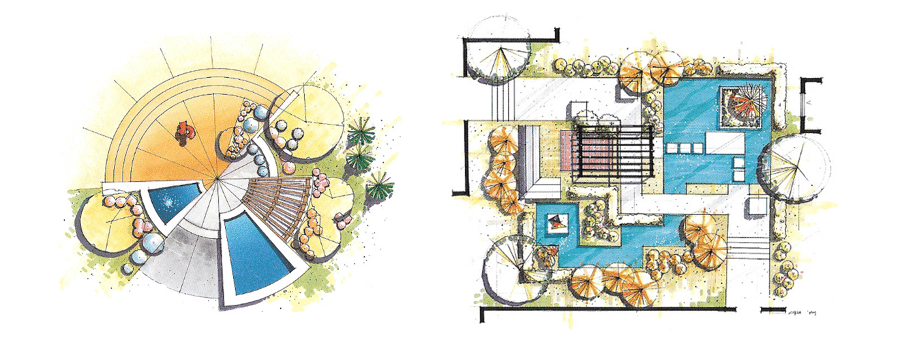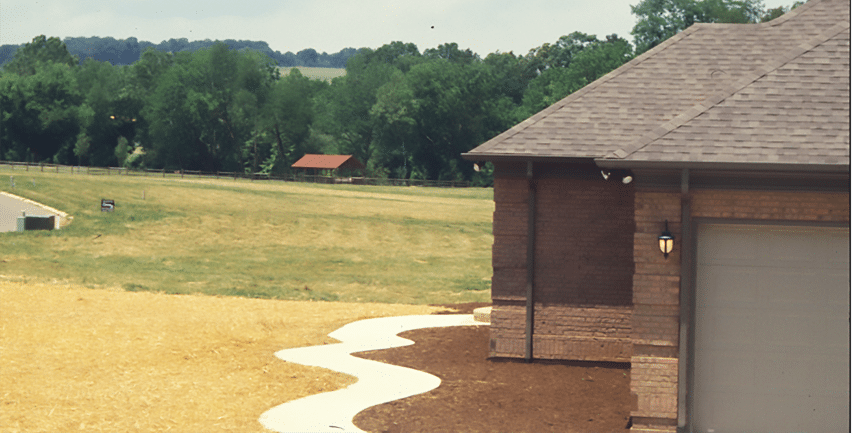Why curves aren’t always the answer

We are often tempted to lay out that curvy garden hose to visualize garden spaces but there are other possibilities.
“When in doubt, round it out.” To look around today’s landscape, one must wonder if this is the designer’s mantra. Curves, you see them everywhere. I know I too have sketched out my share of meandering, flowing lines for both beds and walkways. Curvilinear walkways and bed edges can indeed provide comfort to the visitor and soften the otherwise harsh edges of our built environment. The question is “Are they always the right approach?”
BASIC DESIGN THEMES
There exist so many different methods of laying out a garden design that it may be of some benefit to do a little refresher.
ARC & TANGENT: In this style, the design begins with straight lines which are later softened with arcs. These arcs have to be substantial though. They can’t be small, token curves.
CIRCULAR: Using concentric circles radiating from specific points may create a dynamic but still meaningfully designed space.
ORGANIC: You’ve heard it said “There are no straight lines in nature”. Directional lines and their resulting spaces in an organic design flow with the natural topography for a very fluid, natural feeling.
GEOMETRIC (30, 45, 60 & 90 DEGREE ANGLES): Design using straight lines and angles to create space and patterns not found in nature and the basis for this article.

(Above images from Mike Lin’s Drawing and Designing with Confidence)
ASKING ARCHITECTURE
Just as you wouldn’t want to put a formal brick walkway through a serene woodland garden, it would also seem a bit odd to encounter meandering, mulched paths in the area leading to your front door (unless you live in a woodsy, rural setting). Look around and see what the surrounding architecture tells you. In many instances, small entry courtyards are surrounded by the geometry of the adjacent street, drive, and building. To overlay random curves and organic shapes is to invite a certain amount of conflict and tension. Scale is also a major factor. In smaller spaces where every inch counts, it is very difficult to superimpose natural free forms into the design. Even placing a simple circle or ellipse may result in acute angles where these touch other lines and many of us know that acute angles are a big no-no in design.
THE NATURE OF THE SITE
Designing with geometric lines works best on level ground. Perhaps that is why we see curves in so many gardens or at least where I am, in East Tennessee. If your site allows (relatively flat or urban in which case it is also likely flat), try a creative, geometric approach. Here is a trick you may experiment with on sites that are long and narrow, especially backyards. Try creating a long axis between opposite corners (see design illustration). By doing so, you are taking advantage of the longest possible measurement, thus creating the illusion of more space. In addition, you may also be creating some very cool alcoves and niches which could be developed into smaller, sub-spaces.
THE ALL-IMPORTANT EDGE
The beauty is in the details. With garden design, the attraction is not only in the plant material but also in the edge. Unfortunately, those crisp lines that may be observed on paper don’t always translate well onto the actual site. When employing geometric shapes all edges must be well defined. Certain materials for bed edging are more appropriate than others. Brick, steel, or a quarried stone will look much better in the landscape than irregular field stone or a natural trench-type edge. A contrasting or defining band along walkways and other hardscape elements will also do much to reinforce a strong direction or shape. Laying out the garden with stakes and string will prove much more reliable than just eyeballing and whipping out the marking paint. Here is a post I wrote addressing the edge in detail: https://garrymenendez.com/regaining-the-edge/

I saw this as I was waiting for a client to come to the door next door. Someone took it to heart when they read in the latest Southern Living that “curves are in”.
THE GEOMETRIC GRID
An easy way to begin any garden design is to lay out your base plan and immediately overlay some tracing paper. There are prominent lines that make up the house or structure. Projecting these lines outward into open spaces will guide you in creating spaces that make sense. The lines projecting from perimeter walls are called major lines of force and those lines which may extend from windows and doors are called minor lines of force. Begin by using lines perpendicular and parallel to the structure for one concept and then try rotating those lines of force 30, 45, or 60 degrees to create a totally different design. The geometry which is the result of this design approach can be very appealing and portray a professional appearance which may not be possible with free-form, organic shapes.

On the left, the typical curvy entry. On the right, an entry “garden” created with some geometry.
There are a couple of great design books out there that will help you appreciate the grid overlay concept. One is From Concept to Form in Landscape Design by Grant W. Reid ASLA. The other is a little more comprehensive but also does a great job of directing the reader toward good design and its title is Residential Landscape Architecture by Norman Booth and Tony Hiss.
No matter how you approach garden creation, design is all about experimentation. There is no doubt that technology can greatly improve the way we work and design. However, I still believe in the creative connection that exists between the hand that draws and the brain, a connection that may be lacking when relying on the click of a mouse and a screen but that’s another article. My point is, don’t be afraid to tape down some of that good old tracing paper over your base map and quickly try some different design approaches. Whether your edges and hardscapes are curved, angular, or create 90-degree turns, eventually the light bulb in your brain will spark and you’ll see the solution. Just as the pleasure from any trip can be in the journey, design is a profession where you should enjoy the process as much as the result.
Till next time,
LOVE A STRAIGHT LINE!
Please share and subscribe! https://ahomeforyourgnome.com/

